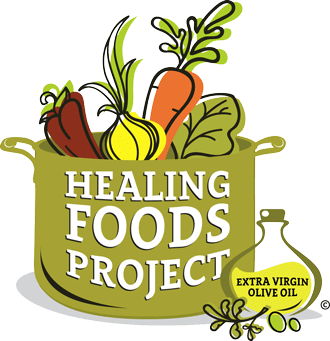ABOUT the HEALING FOODS PROJECT
HOW THE PROGRAM STARTED

Dr. Flynn designed her nationally-recognized plant-based, extra virgin olive oil diet in 1999 and began to focus her research on its results shortly after. Her initial research tested how this diet compared to conventional lower fat diets for improvement in body weight and risk factors for chronic diseases.
Early in her research, Dr. Flynn’s study participants touted that the diet’s meals were not only easy to prepare and tasted good, but were also less expensive than what they had been eating. This led Dr. Flynn in 2007 to develop a 6-week cooking program using recipes that follow her plant-based, extra virgin olive oil diet for clients of food pantries.
When Rev. Mary Margaret Earl, the former Associate Director of McAuley House read about the program and its study results, she invited Dr. Flynn to work with McAuley House to develop recipes that could be implemented in large scale for low-income, congregate meal sites. This led to the Healing Foods Project.
ABOUT DR. MARY FLYNN
Flynn began teaching at Brown University in 1998, and the courses she teaches are Principles of Nutrition and Diet, and Chronic Diseases. Her main research interest is how food is related to the development and treatment of chronic diseases. She has developed a plant-based olive oil (PBOO) diet that is moderate in fat content and uses foods that scientific literature suggests will improve health. Dr. Flynn has used the diet for weight loss and for improving risk factors for chronic disease, and for decreasing food insecurity.
A WORD ABOUT THE HEALING FOODS PROJECT
FROM LARRY LoVERDE, KITCHEN MANAGER OF McAULEY HOUSE MEAL SITE
As Kitchen Manager, I am impressed by how quick and easy these recipes are to prepare. In addition, if you find that you suddenly have more people to feed than expected, additional beans and legumes are a snap to sauté to stretch the meal.
My greatest concern when we began the Healing Foods Project’s plant-based meals several times a week was how our guests would respond to meals that were not based on meat. In a very short time, our guests, numbering up to 300 a day, began to accept and then enjoy these new meals. Now we actually have guests requesting extra virgin olive oil on their tables for dipping.
Looking back at the nearly two years we’ve been serving Healing Foods, I take great pleasure in the fact that we are contributing to the overall health of our guests, not merely filling bellies. We are helping people to look at food differently and perhaps to make some better choices in their diet.
THE BASICS AND FOODS OF HFP RECIPES
The main foods that are used in Healing Foods Project recipes are:
- Extra virgin olive oil
- Canned vegetables (carrots, corn, green beans, peas and tomato)
- Frozen vegetables (broccoli, corn, peas, spinach)
- Whole wheat pasta and brown rice
- Canned beans/legumes (black, garbanzo, kidney, white cannellini)
Per serving, the recipes for the Healing Foods Project program follow a basic formula:
- Approximately one-and-a-half tablespoons of extra virgin olive oil
- 1 cup (2 servings) of vegetables
- 3 to 4 ounces (dry weight) of starch
You can use this combination to create your own recipes depending on what you have on-hand. You can also easily increase a recipe that is already cooked if more guests arrive than expected.
INGREDIENT SUBSTITUTIONS IN MEALS
Preparing food in a non-profit meal site or soup kitchen has its own challenges, one of which is that you don’t always know what you’ll have on hand to cook. An unexpected donation can change your day. Below are some helpful ingredient substitutions that have worked well at McAuley House, and that we wanted to share.
- While preparing the Spinach, Beans and Pasta meal, a local farmer dropped off two cases of fresh kale. The spinach went back into the freezer and we substituted sautéed kale into the recipe. It came out great!
- At McAuley House, we’ve found that the Corn, Black Beans and Tomato Fried Rice recipe is a great example of a substitution-friendly meal. A little chili powder, crushed tomato and cumin quickly turn it into veggie chili. And, we’ve been known to throw in “whatever there’s a lot of” on occasion, which is particularly true in the summer when fresh vegetable donations are bountiful.
- With the Vegetable Lo Mein dish, we had recently received a donation of Vietnamese pho soup base (which has flavors of lemon grass and lime) and water chestnuts. The result was a wonderful Asian stir-fry with noodles.
Please know that this is just a guide to some ingredient substitutions we’ve had success with. Use your instincts and imagination; you know what tastes good together. Just be sure to use good extra virgin olive oil, the recipes in the cookbook, and lots of love!
FAQ
What do I need to do to get a program like this working at my meal site?
Are there any additional costs to implement this program?
Does it have to be extra virgin olive oil?
Why do the recipes call for so much olive oil? I can sauté with much less.
Should we introduce the program with guests?
Does anything need to be done differently on the days we serve Healing Food Project meals?
What role does the meal site Leadership Team play in this program?
How can I get the cookbook or recipes?
Where is the protein in the meals?
Do I need to defrost frozen vegetables before adding them to the recipes?
Does it have to be whole wheat pasta and brown rice?
I’ve heard that brown rice is tricky to cook. Has that been a problem?
Does it matter what type of beans I use in the meals?
How do I get more information on starting this program, or to schedule a presentation?
About HEALING FOODS
The Healing Foods Project and its materials are available fro our nonprofit to yours. It is part of the mission of McAuley Ministries to better the lives of the poor and hungry. Through Healing Foods, we are ready to engage in discussions with those who want to implement the program at their meal site. McAuley Ministries is an independent nonprofit 501(c)(3) organization.
Contact
Phone
© 2021 McAuley Ministries
